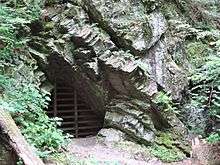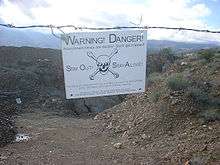Abandoned mine
An abandoned mine is a mine or quarry which is no longer producing or operational, though definitions vary.
An abandoned mine may be a hazard to health, safety or environment.
Definitions
United States

- Department of the Interior - Bureau of Land Management - Abandoned mines are those mines that were abandoned prior to January 1, 1981, the effective date of the Bureau of Land Management's Surface Management regulations issued under authority of the Federal Land Policy and Management Act of 1976, as amended (43 U.S.C. 1701 et seq.)[1]
- Environmental Protection Agency - Abandoned mine lands (AMLs) are those lands, waters and surrounding watersheds where extraction, beneficiation or processing of ores and minerals has occurred.[2]
Canada
- National Orphaned/Abandoned Mines Initiative - Orphaned or abandoned mines are those mines for which the owner cannot be found or for which the owner is financially unable or unwilling to carry out clean-up. They pose environmental, health, safety and economic problems to communities, the mining industry and governments in many countries, including Canada.[3]
Hazards
The term incorporates all types of old mines including underground shaft mines and drift mines, and surface mines including quarries and placer mining .
Abandoned mines are found throughout the world. They contain many hazards to the unwary who venture around them, including:
- Subsidence (collapsing ground)
- Blasting caps and other undetonated explosives
- Blackdamp accumulating in old mines, which can cause suffocation
- Hidden mine shafts, often hidden beneath bushes and grasses and other vegetation that has grown up around the mine entrance
- Unstable roofs and passageways, prone to cave-ins
Abandoned Mines in the United States
In the USA there are thousands of abandoned mines. The precise number of abandoned mines in the United States remains an unknown, ranging "from the National Park Service's tally of 2,500 on its lands, to the Mineral Policy Center's assessment of 560,000 abandoned mines on public and privately owned lands."[4] Many of these abandoned mines are associated with abandoned neighboring towns often referred to as ghost towns. Experts strongly warn against entering or exploring old or abandoned mines.

In the U.S., the estimation is that approximately 25% of the abandoned mine lands (AML) sites pose physical safety hazards.[5] Old mines are often dangerous and can contain deadly gases. Since weather may have eroded the earth/rock surrounding it, the entrance to an old mine in particular can be very dangerous. Old mine workings, caves, etc. are commonly hazardous simply due to the lack of oxygen in the air (a condition in mines known as blackdamp). Blackdamp is a deadly killer which provides no warning to any individual or group of individuals entering such an environment.
Every year, dozens are injured or killed in recreational accidents on mine property. It is only fair to note, however, that the majority of the deaths are unrelated to mine exploration. Drownings in open quarries and ATV accidents on abandoned mine properties are the main cause of accidental death. The U.S. Department of Labor notes that since 1999, "more than 200 people have died in recreational accidents at surface and underground active and abandoned operations across the country."[6] Due to these circumstances, MSHA (Mine Safety and Health Administration) launched the "Stay Out – Stay Alive" campaign, which is a national public awareness campaign aimed at warning and educating children and adults about the dangers of exploring and playing on active and abandoned mine sites.
In the U.S., the Abandoned Mine Land Initiative, launched by the Western Governor's Association and the National Mining Association is also an effort focusing on reporting the number of high-priority AML sites.[7] The initiative identifies, measures and reports on the progress of current reclamation cleanup programs on an annual basis. In the Americas region, the United Nations Environment Programme (UNEP) and the Chilean Copper Commission (COHILCO) co-hosted a workshop to address the problem of abandoned or "orphaned" mines.[8] Including a representative from the UN, ten countries were represented from North, Central and South America with an eleventh participant being Japan.
See also
References
- ↑ blm_admin (2016-10-01). "Programs: Public Safety and Fire: Abandoned Mine Lands: About AML". www.blm.gov. Retrieved 2018-04-12.
- ↑ "Abandoned Mine Lands". Superfund. U.S. Environmental Protection Agency. Retrieved 28 January 2018.
Abandoned mine lands (AMLs) are those lands, waters and surrounding watersheds where extraction, beneficiation or processing of ores and minerals has occurred. AMLs can pose serious threats to human health and the environment.
- ↑ "NOAMI | National Orphaned/Abandoned Mines Initiative". www.abandoned-mines.org. Retrieved 2018-04-12.
- ↑ "KEEP OUT! — Old Mines Are Dangerous (U.S. Department of the Interior)". 2008-05-12. Retrieved 2018-04-12.
- ↑ Greeley,, Michael N. (2008-10-14). "National Reclamation of Abandoned Mine Lands". SME. Retrieved 2018-04-12.
- ↑ "MSHA - News Release: 03/19/2007 - MSHA issues warning to children and adults to 'Stay Out and Stay Alive' -Dozens injured and killed each year in recreational accidents". arlweb.msha.gov. Retrieved 2018-04-12.
- ↑ "Cleaning up Abandoned Mines: A Western Partnership" (PDF). Western Governor's Association. 2007-09-26. Retrieved 2018-04-12.
- ↑ "Abandoned Mines: Problems, Issues and Policy Challenges for Decision Makers. Summary Report" (PDF). Chilean Copper Commission (COHILCO) and United Nations Environment Program: Division of Technology, Industry and Economics. 2007-01-29. Retrieved 2018-04-12.
External links
- Abandonedmines.gov- United States Federal Mining Dialogue Workgroup web portal
- Abandoned Mine Lands- Department of the Interior - Bureau of Land Management
- Abandoned Mineral Lands - Department of the Interior - National Park Service
- Abandoned Mine Lands - Department of Agriculture - United States Forest Service
- Stay Out - Stay Alive - Department of Labor - Office of Mine Safety and Health Administration
- National Orphaned Mine Initiative - Canada - National multi-stakeholder Workgroup